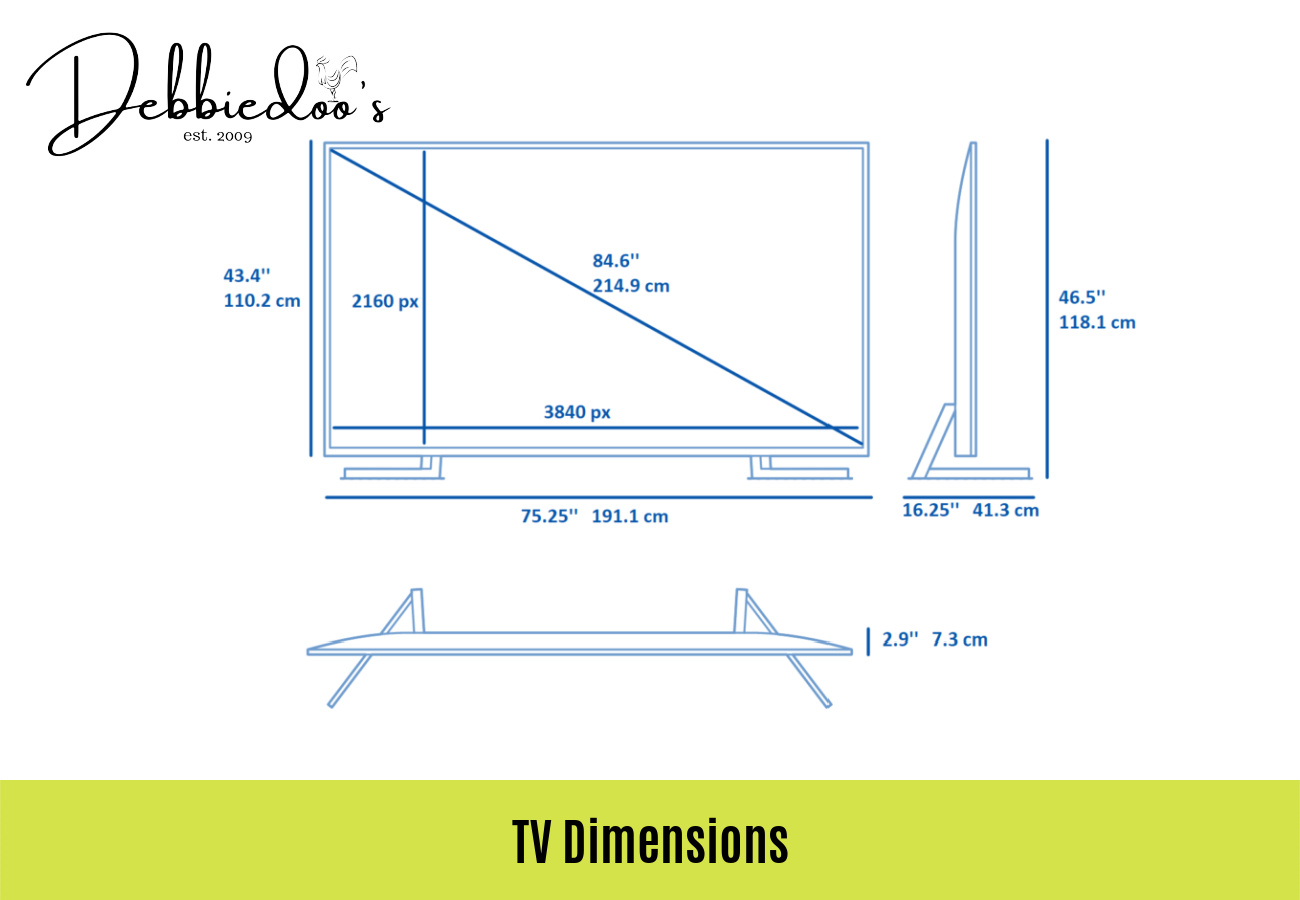Television dimensions are crucial in determining how well a TV fits into your living space and how enjoyable your viewing experience will be.
When trying to pick the right TV size, you should take a few aspects into account, like your room size, layout, and viewing habits.
This article aims to provide a comprehensive guide to understanding TV dimensions, helping you choose the perfect size for your space.
TV size dimensions
| Screen size (inches) | Aspect ratio | Approximate width (inches) | Approximate height (inches ) | Optimal viewing distance for 1080p HDTV (inches) | Optimal viewing distance for 4K UHD TV (inches) |
| 32 | 16:9 | 28 | 16 | 48 – 80 | 32 – 48 |
| 43 | 16:9 | 38 | 21 | 64.5 – 107.5 | 43 – 64.5 |
| 48 | 16:9 | 42 | 24 | 72 – 120 | 48 – 72 |
| 50 | 16:9 | 44 | 25 | 75 – 125 | 50 – 75 |
| 55 | 16:9 | 48 | 27 | 82.5 – 137.5 | 55 – 82.5 |
| 60 | 16:9 | 52 | 29 | 90 – 150 | 60 – 90 |
| 65 | 16:9 | 57 | 32 | 97.5 – 162.5 | 65 – 97.5 |
| 75 | 16:9 | 66 | 37 | 112.5 – 187.5 | 75 – 112.5 |
| 85 | 16:9 | 74 | 42 | 127.5 – 212.5 | 85 – 127.5 |
How to measure TV size

TV screen sizes are measured diagonally, from one corner to the opposite corner. Use a measuring tape or ruler to calculate the distance between these two points.
Remember that full TV dimensions also include the bezel, or frame, surrounding the screen – not just the width and height.
Flat screen TV dimensions
Flat screen TV dimensions refer to the overall measurements of a flat screen TV, including its screen size and the bezel or frame surrounding the screen. They vary by screen size, aspect ratio, and design elements such as the bezel’s thickness.
Aspect ratio is simply the relationship between the width and height of a screen. It’s like a fraction that shows how many times the width fits into the height. Common ones are 4:3, like old TVs, and 16:9, which is what widescreens usually have. It helps keep the picture looking right when you change sizes or formats. The most common aspect ratio for modern TVs is 16:9, meaning that the width is 16 units while the height is 9.
To get the approximate width and height of a flat screen TV, use the aspect ratio (commonly 16:9) and screen size, dividing the screen size by the square root of (16^2 + 9^2), which is approximately 18.36. Multiply the result by 16 to get the width and by 9 for the height. Remember that these measurements are for the screen itself, and you should add the bezel width and height to get the overall TV dimensions.
Dimensions for common TV sizes
The following are approximate dimensions for common TV sizes, based on a 16:9 aspect ratio:
- 32-inch TV dimensions: 28 x 16 inches
- 43-inch TV dimensions: 38 x 21 inches
- 48-inch TV dimensions: 42 x 24 inches
- 50-inch TV dimensions: 44 x 25 inches
- 55-inch TV dimensions: 48 x 27″ inches
- 60-inch TV dimensions: 52 x 29 inches
- 65-inch TV dimensions: 57 x 32 inches
- 75-inch TV dimensions: 66 x 37 inches
- 85-inch TV dimensions: 74 x 42 inches
TV size distance: optimal viewing distances
To discover the best viewing distance to your TV, multiply the diagonal screen size by the recommended multiplier for your TV’s resolution: 1.5 to 2.5 for 1080p HDTV, and 1 to 1.5 for 4K UHD TV. This will give you a range of distances for the most comfortable and immersive viewing experience.
For example, the ideal viewing distance for a 50-inch 1080p HDTV is between 75 and 125 inches. In the case of a 50-inch 4K UHD TV, you should settle for anything between 50 and 75 inches.
What size TV do I need?
To figure out the best TV dimensions for your specific situation, it’s important to assess the following aspects:
- Room size and layout: The size of your room and its layout are important factors when determining the best TV size for your space. For example, think about where you prefer to sit when watching TV and where the windows and other furniture are related to the TV. It shouldn’t be too close or too far from your viewing area.
- Preferred content and viewing habits: Your preferred content and viewing habits can also influence the best TV size for your needs. If you watch a lot of movies or play video games, a larger TV may enhance your experience. However, if you primarily watch the news or talk shows, a smaller TV might be more suitable.
- Resolution and sound quality: When choosing a TV, it’s essential to balance size with other features like resolution and sound quality. A larger TV with a lower resolution may not offer the best viewing experience. On the other hand, a smaller TV with better sound quality might be more enjoyable for some people.

